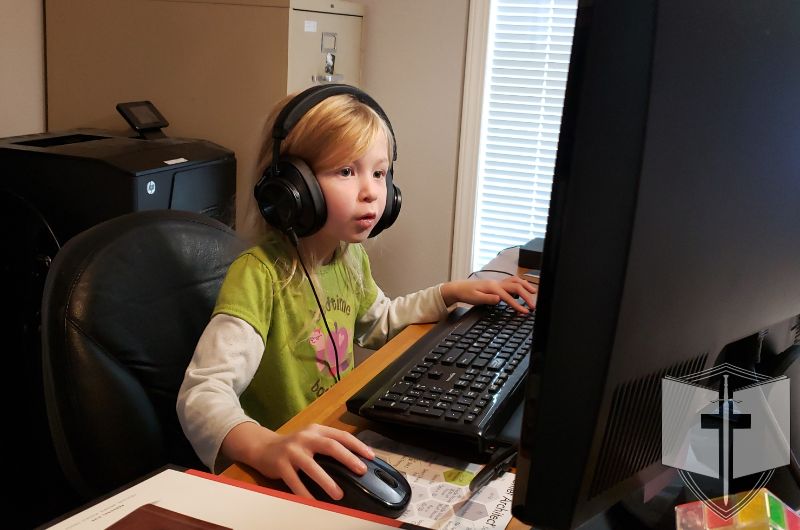But no one can enter the strong man’s house and plunder his property unless he first ties up the strong man, and then he will plunder his house.
The Internet has completely changed the types of things parents have to think about when attempting to educate and protect their children for life. When I was growing up, the Internet was still fairly new, and my parents had to begin learning how to teach and educate us kids on which types of websites we should avoid or avoid looking for.
This was primarily because the Internet was fairly new and while there were malicious or questionable sites out there, you pretty much had to go looking for them. That’s all changed in recent years. Not only have more sites been launched but, with the emergence of the advertising market, more and more inappropriate content is being pushed in front of us as we browse. This means that as parents today, we have our work cut out for us in both educating and mentoring our kids on the proper use of this powerful tool. Just as with any tool, you must use it properly or be hurt by it. The same applies to the Internet. The Internet is a tool that powerfully enables communication and research and even though there are some bad actors out there it is possible to use it correctly while avoiding “injury”.
Here are a few tips on setting up your computer to browse safely on the internet and make it a little easier for you to share this tool with your kids.
-
Set up a custom DNS (Domain Name System) server.
A DNS server provides your computer or device with the ability to connect to a website by entering its name. For example, when you open your browser and type “duckduckgo.com”, your computer connects to a DNS server and asks for the IP address of “duckduckgo.com”. The DNS server contains an index of IP addresses and their assigned domain names in the Domain Name System and returns the IP address of the requested site to your computer and your computer then connects to that IP address.
So why is this important for Internet safety? Simply because choosing a DNS that provides a little extra protection can go a long way. There are a few out there but, I prefer OpenDNS. OpenDNS performs all the actions of a standard DNS server, but, in addition to keeping an index of all the different sites and their IP addresses, it also maintains a black list of known, bad, sites. It then compares all requests from your computer to this black list and denies any requests to those sites. Visit https://opendns.com/ and follow their guide for setting up your computer, or even your entire home network to use their DNS servers and you will immediately be protected from a huge list of sites. -
Install a good adblocker.
Ad blockers are extensions to your browser that scan the pages you visit for advertisements and even malicious or invasive scripts and block them. The one I like is called Privacy Badger. Privacy Badger is open source and free. This means that anyone can download and audit their code and they are not funded by selling access to your browsing data to allow only paid ads as some other adblockers might do. It can be fairly aggressive but, if a site doesn’t work the way it should, you can simply click on the extension and click “Report broken site” and that site will be temporarily added to a white list and reported to the development team so they can attempt to improve their extension to work better on that type of site.
The main benefit, however, is simply that ads and banners that may contain inappropriate content are simply gone from almost any site you visit and you don’t even notice it in most cases.
Another side bonus of using an extension like this is that pages are likely to load a little faster because Privacy Badger is blocking the extra advertising and tracking scripts and therefore only the main content of the page is loaded minus all the extras. -
Install Spybot Search and Destroy.
Spybot Search and Destroy is a program that modifies your computer’s hosts file to prevent redirects to known bad sites through its Immunization feature. The hosts file is essentially a set of rules that tells your computer what to do if certain sites are requested.
This helps protect you against spyware but, has the added benefit of preventing your computer from being able to even visit certain types of sites either by accident or on purpose. The request for those sites is simply thrown away silently and ignored by your computer.
This is specific to Windows computers only so unfortunately, you won’t be able to use this on any other type of device.
Those are my three favorite ways to protect a system from malicious or inappropriate content on the Internet and as a byproduct, your system will be safer from potential viruses and other malware too.
Of course, all of this is great, but, it’s just a safety net. While your children are in your home they are protected by this safety net but, when they go to the library or a friend’s house they are no longer in the safety of this net. This is why we must have conversations with our kids about what the world promotes on the Internet or television and how to handle it appropriately. Being honest about the dangers and how they can be affected and what to do should anything come up. Your kid’s trust in your desire to protect them is what’s going to ultimately help keep them safe as they go out into the world wide web and make good decisions to protect their minds and hearts from being plundered by destructive content.

